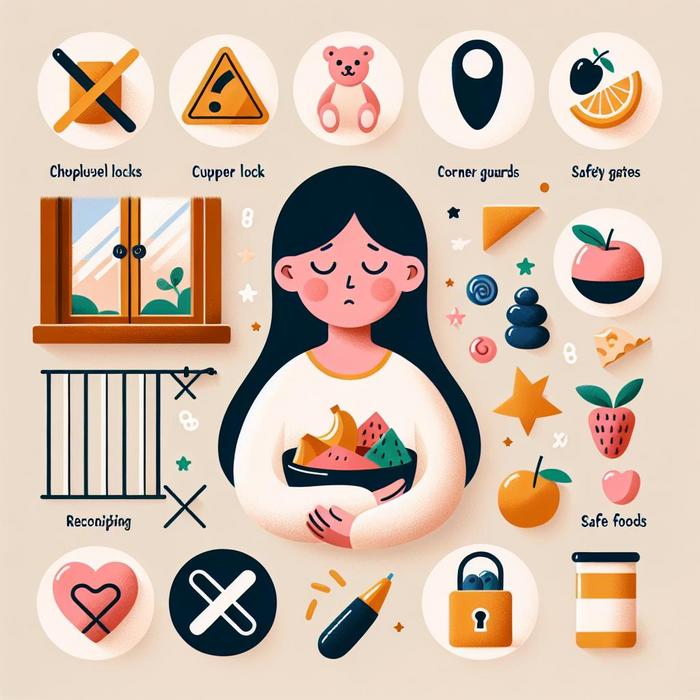Recognizing High-Risk Foods and Objects
The role of a parent is multifaceted and ensuring the safety of your child is one of the essential aspects. Among the myriad of potential dangers, one that might not immediately come to mind is the risk of choking. There are a variety of foods and objects that can pose a choking hazard to young children.
Recognizing these risks is the first step in preventing choking hazards. To help you navigate these waters, let’s examine some troublesome foods and objects.
High-Risk Foods
When introducing solids, food choice is critical. While experimenting with foods is a necessary part of the process, caution must be exercised with certain types. Here are some foods to approach with care or avoid altogether:
- Small, hard foods: These can be a choking hazard as they can easily become lodged in a young child’s throat. Examples include nuts, seeds, and popcorn.
- Round foods: Round foods can perfectly block a child’s airway, posing a high choking risk. Hot dogs, grapes and cherry tomatoes are such examples. Always cut these foods into small, non-round pieces before serving.
- Sticky or chewy foods: Foods like marshmallows, gum, or jelly candies are sticky and can potentially block your child’s airway.
- Chunky or hard-to-chew foods: Foods that require lengthy chewing or are served in large chunks can lead to choking. Meats and cheese fall into this category.
For further information, the Centers for Disease Control and Prevention provide a comprehensive list of foods that are considered choking hazards for small children.
Other Potential Choking Hazards
Besides food, numerous objects around your house can also pose a choking risk. Toys, household items, and even certain baby products can be dangerous.
- Toys with small parts: Always check the age recommendation on toys. Avoid those with small detachable parts for younger children.
- Household items: Small items like buttons, coins, or batteries are potential choking hazards. Try to keep such items out of children’s reach.
- Baby products: Some baby products like pacifiers or bottle caps can pose a choking threat. Always inspect these items for wear and tear.
Child-Proofing Tips and Tricks
Being vigilant about recognizing risks and child-proofing your home can significantly reduce the risk of choking. Here are some useful tips:
- Secure household items: Keep small objects, cleaning supplies, and medicines out of children’s reach.
- Supervise mealtimes: Always keep an eye on your child while they’re eating, especially when introducing new foods.
- Check toys regularly: Inspect toys for any loose or small parts that may present a choking hazard.
- Teach safe eating habits: Show your child how to eat slowly and chew their food well.
It’s always prudent to be prepared for potential choking incidents. Learning basic first aid and CPR can be lifesaving skills in an emergency situation. Responding quickly and effectively can ultimately save your child’s life.
Remember, your baby’s safety is paramount. By considering these tips, you are well on your way to creating a safer environment for your little one. Stay tuned for more on this topic.
Role of Age in Choking Hazards
While certain foods and objects pose choking hazards universally, some risks vary by age. A child’s development plays a significant role in determining the risk of choking.
Infants who are still breastfeeding or bottle-feeding are at a lower risk for choking on food, but this risk begins to increase once the child starts eating solid foods. Then, between the ages of 1 and 4, toddlers become more adept at exploring and tend to put everything they find in their mouths, increasing the risk of choking considerably. School-aged children slightly decrease in the choking hazard risk as they learn to chew and swallow properly.
Preventing Choking Incidents
While it is essential to identify risks and prepare a safe environment, knowing how to respond to a choking incident when it occurs is vital. Here are some important considerations:
- Choking first aid: As a parent or caregiver, learning and periodically refreshing your knowledge about first aid measures for choking is important. This ensures that in the unfortunate event of a choking incident, you can quickly administer appropriate measures and increase the chance of a positive outcome.
- The Heimlich manoeuvre: This is often effective in dislodging food or an object from the airway. However, it must be performed correctly to avoid causing more harm. There are different ways of performing the Heimlich manoeuvre, depending on the age of the child. Ensure to learn the correct method.
- CPR: In severe cases, when a child loses consciousness, performing lifesaving CPR is necessary. Enrolling in a first-aid course is recommended for every caregiver.
The KidsHealth and New York State Department of Health provides detailed information about choking first aid and prevention.
Early Education on Safety
As your child grows older, having conversations about safety is crucial. It’s essential to educate children about potential hazards and the importance of safety practices such as:
- Understanding Risks: Educate your child about which foods and objects are choke hazards, and why they must be avoided.
- Safe Eating Habits: Teach your children the importance of chewing their food thoroughly before swallowing, and why they should not talk or laugh with food in their mouth.
- Playing Safely: Remind children about the dangers of putting toys or other non-food items in their mouths.
- Seeking help: It’s critical that children understand when to ask for help, especially if they think something is lodged in their throat.
Beyond this, continue to remind them about these safety habits consistently. Remember, having these discussions can make a significant difference in keeping your child safe from choking hazards.
When it comes to children’s safety, continuous learning, and proactive approaches are critical. Refer to Raising Children Network for more detailed insights into child safety and choking prevention.
